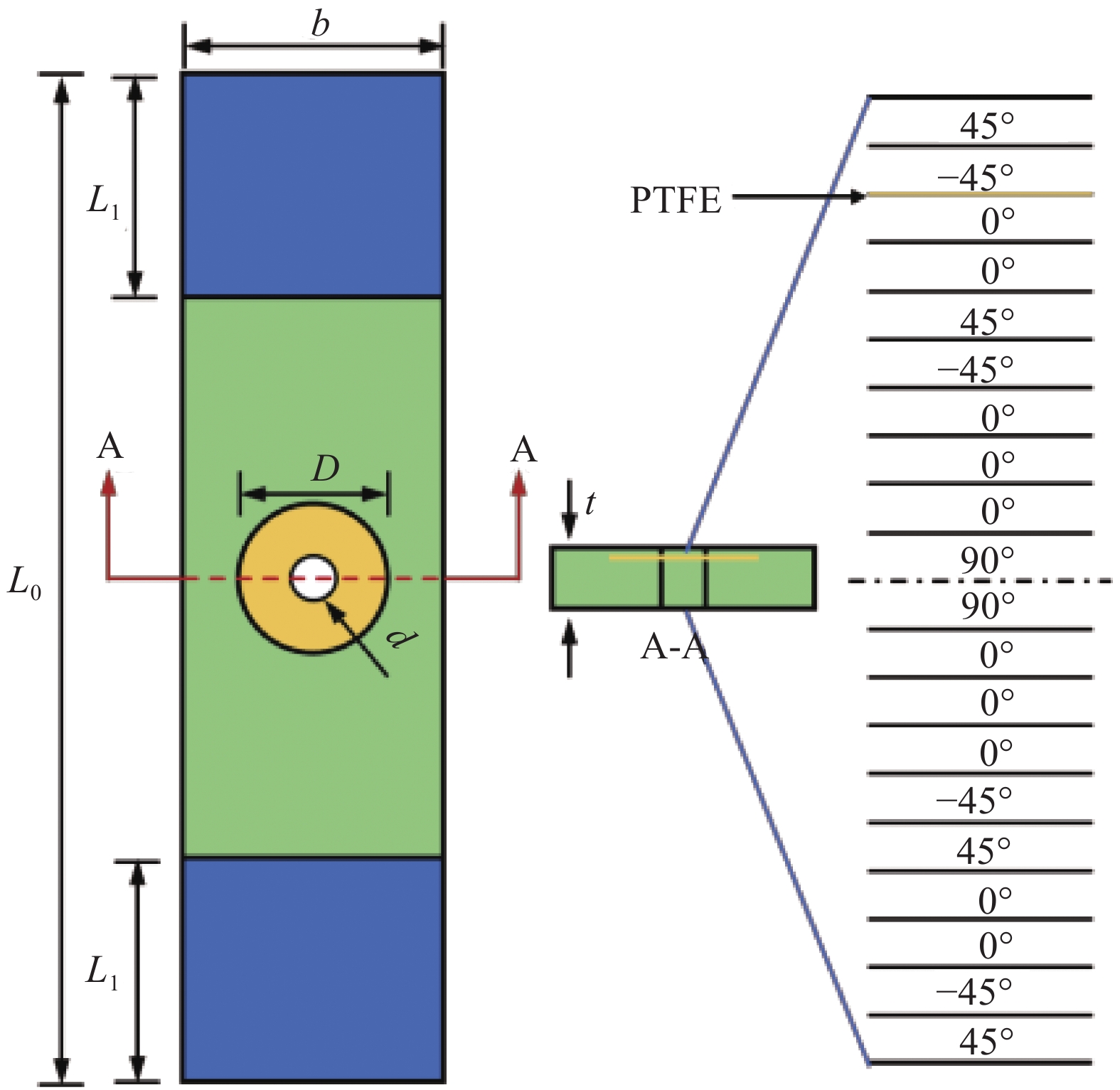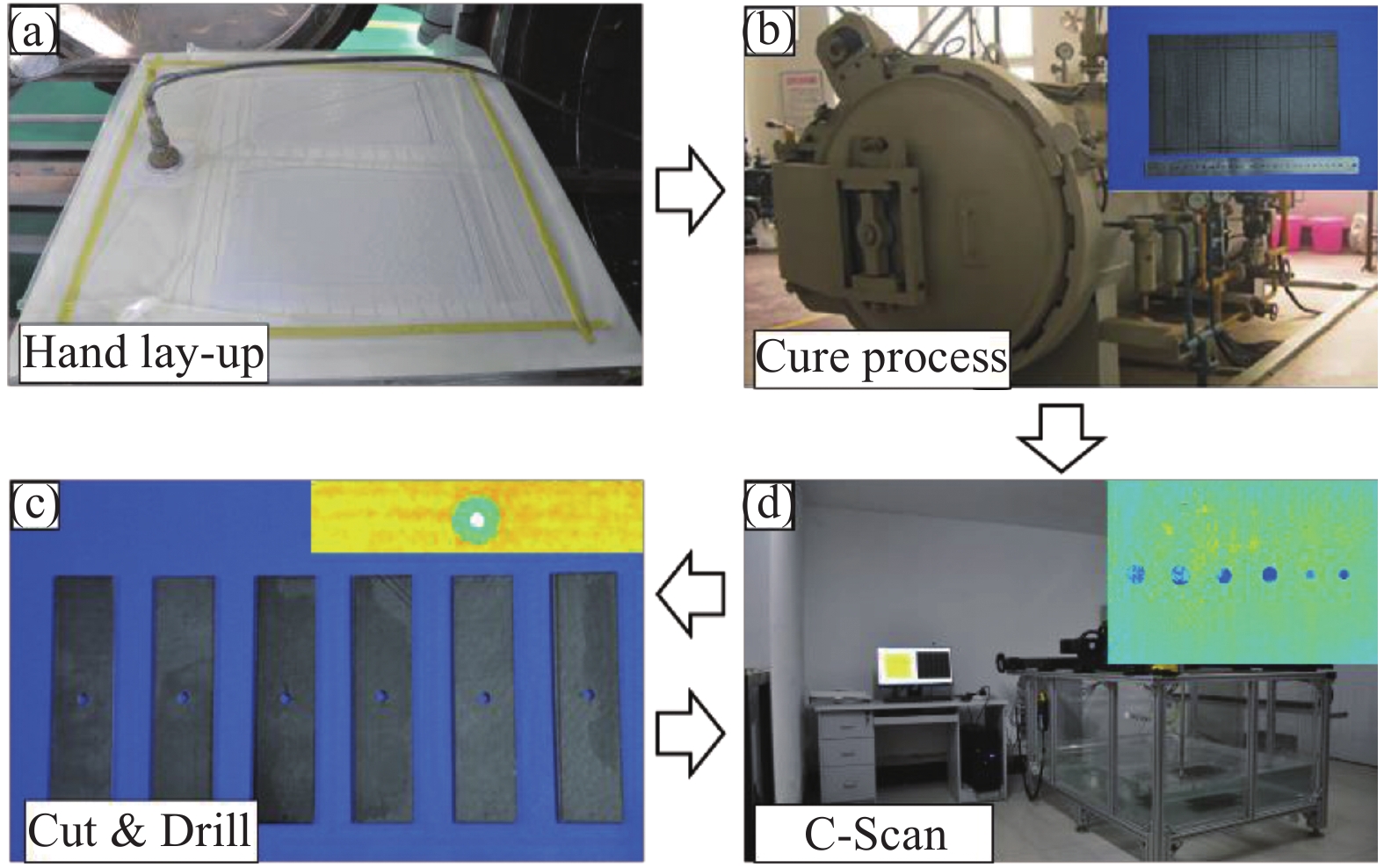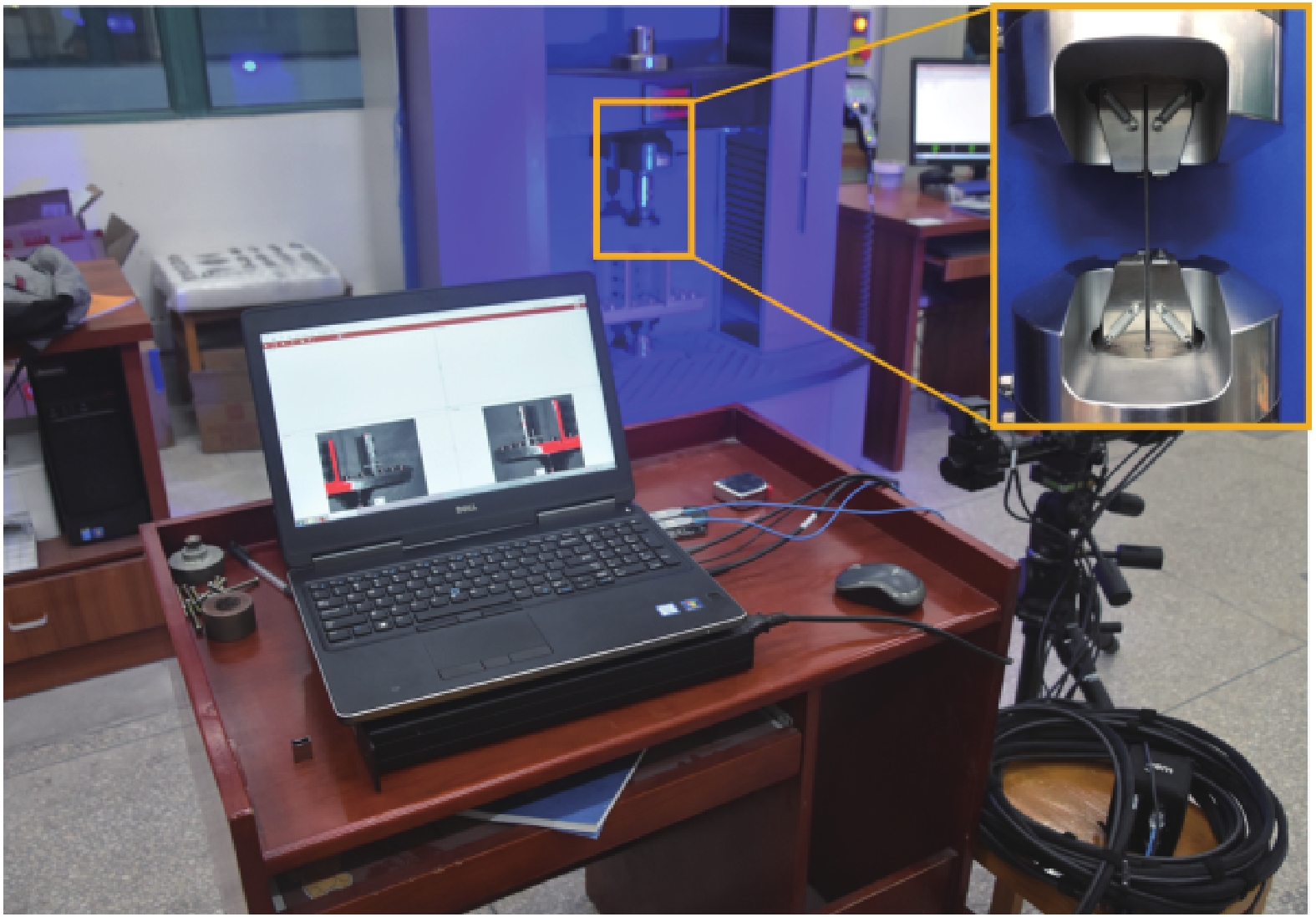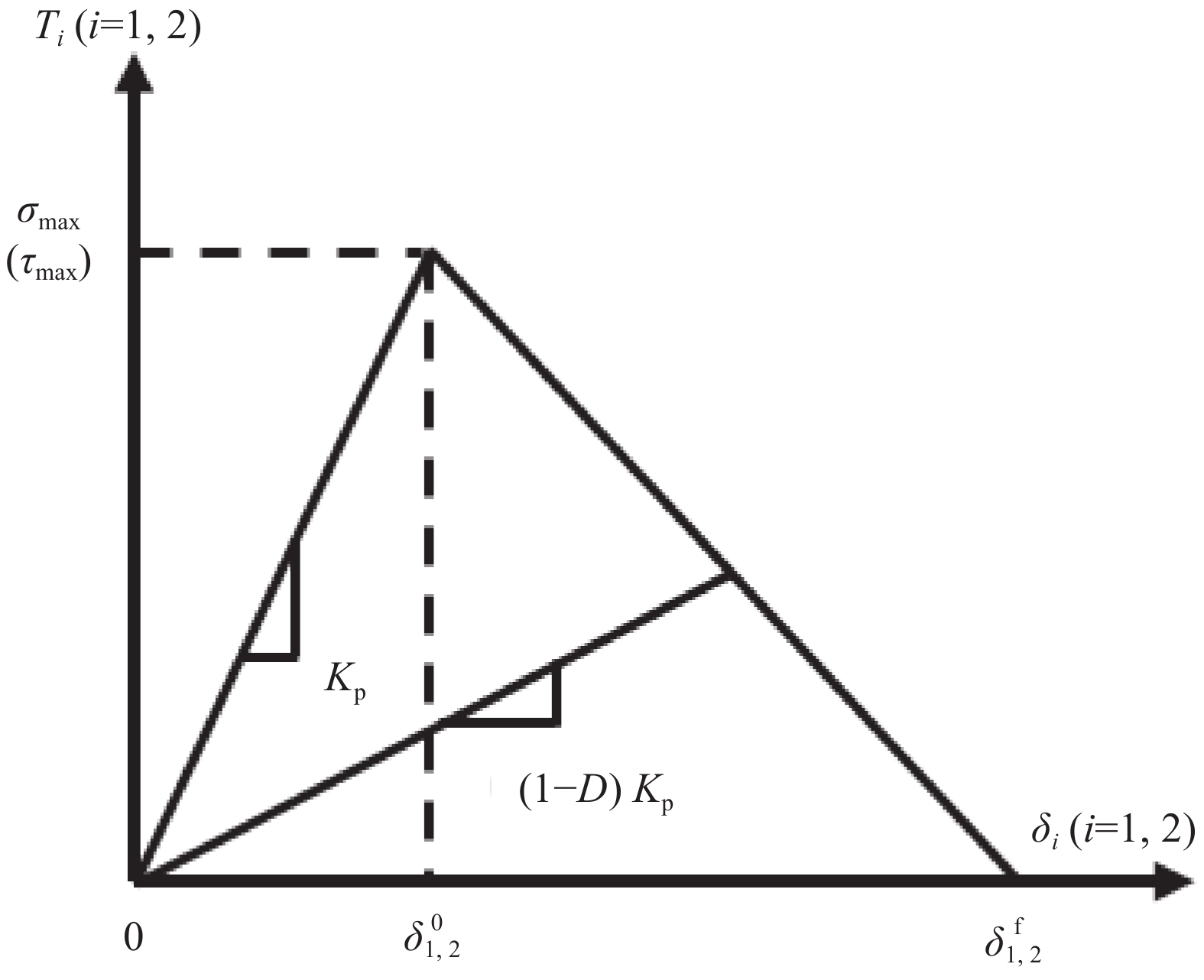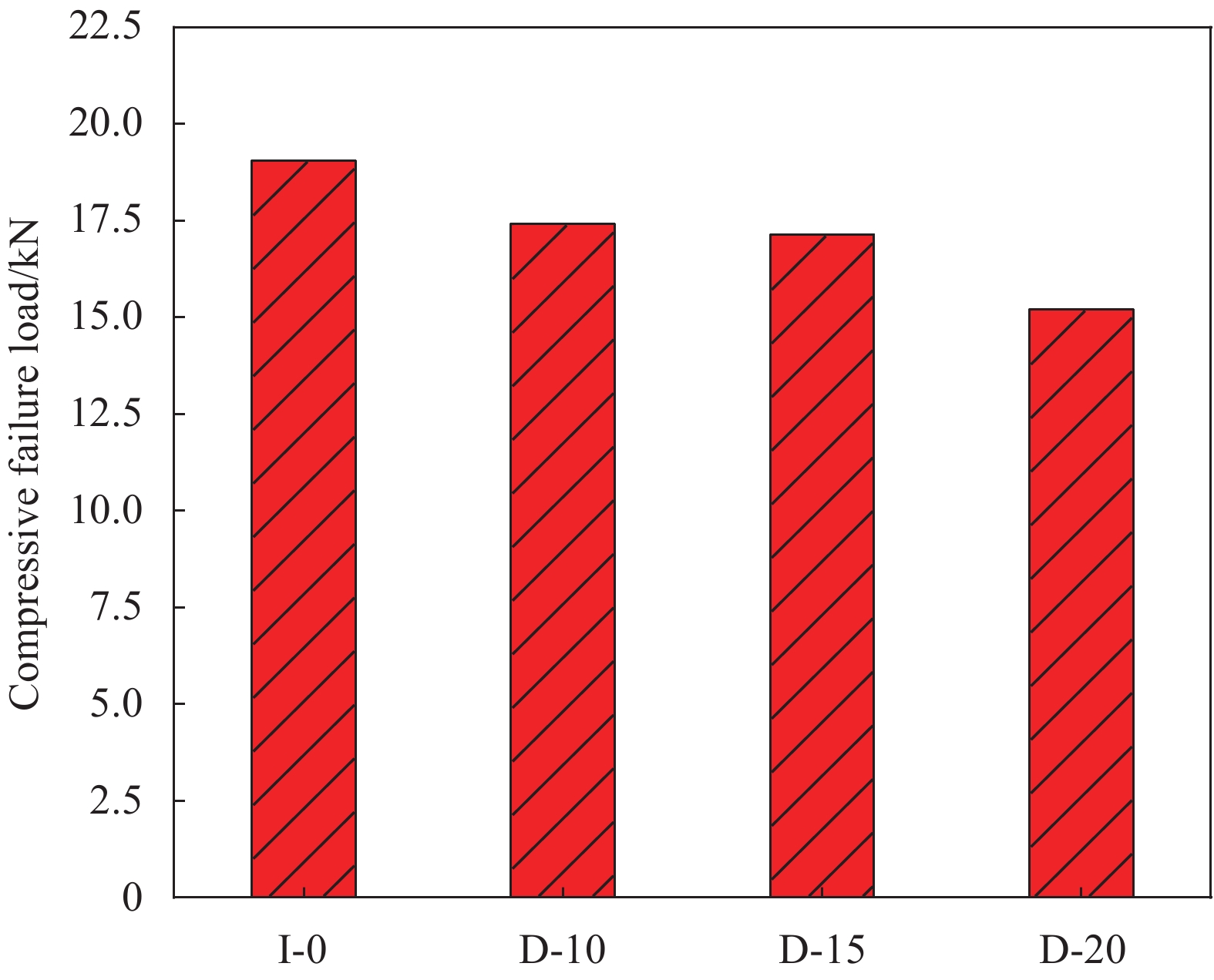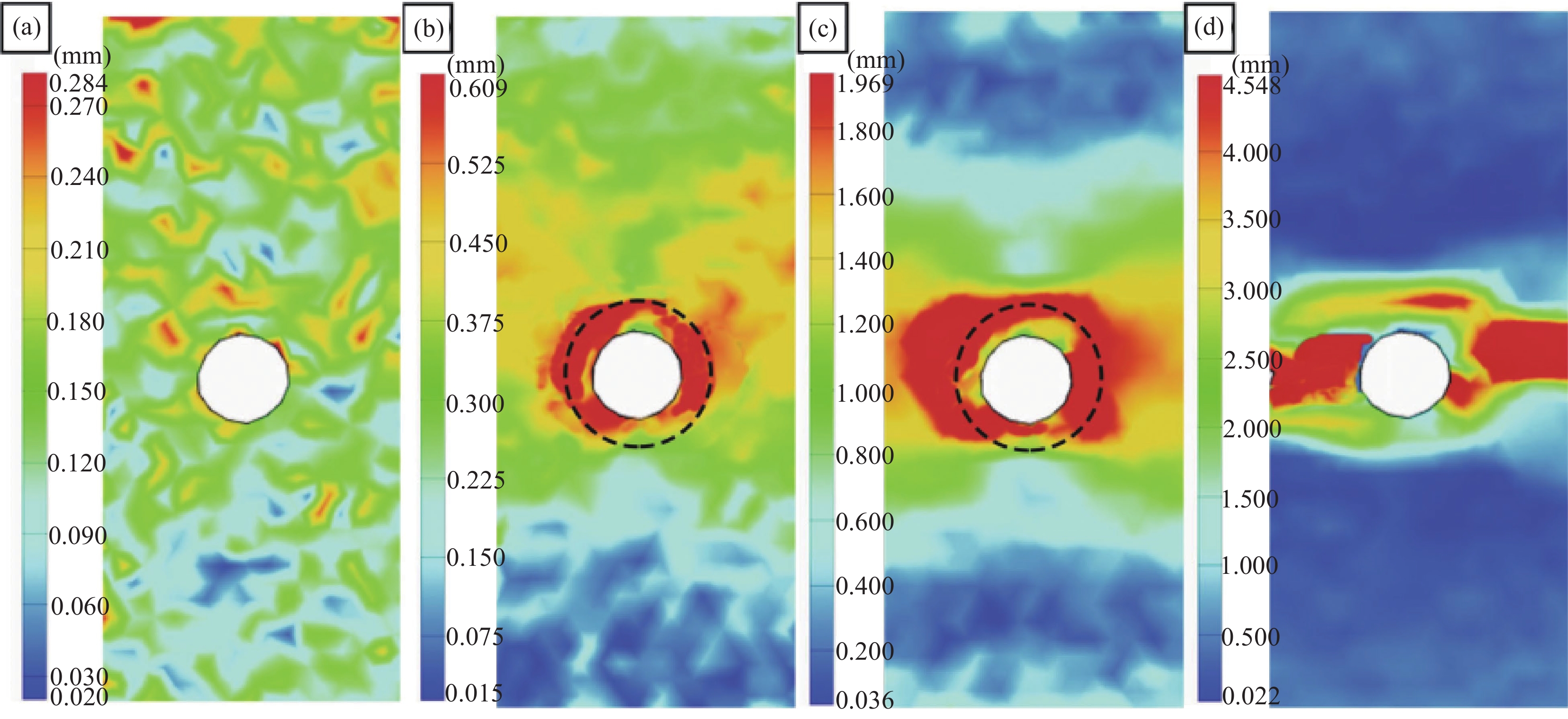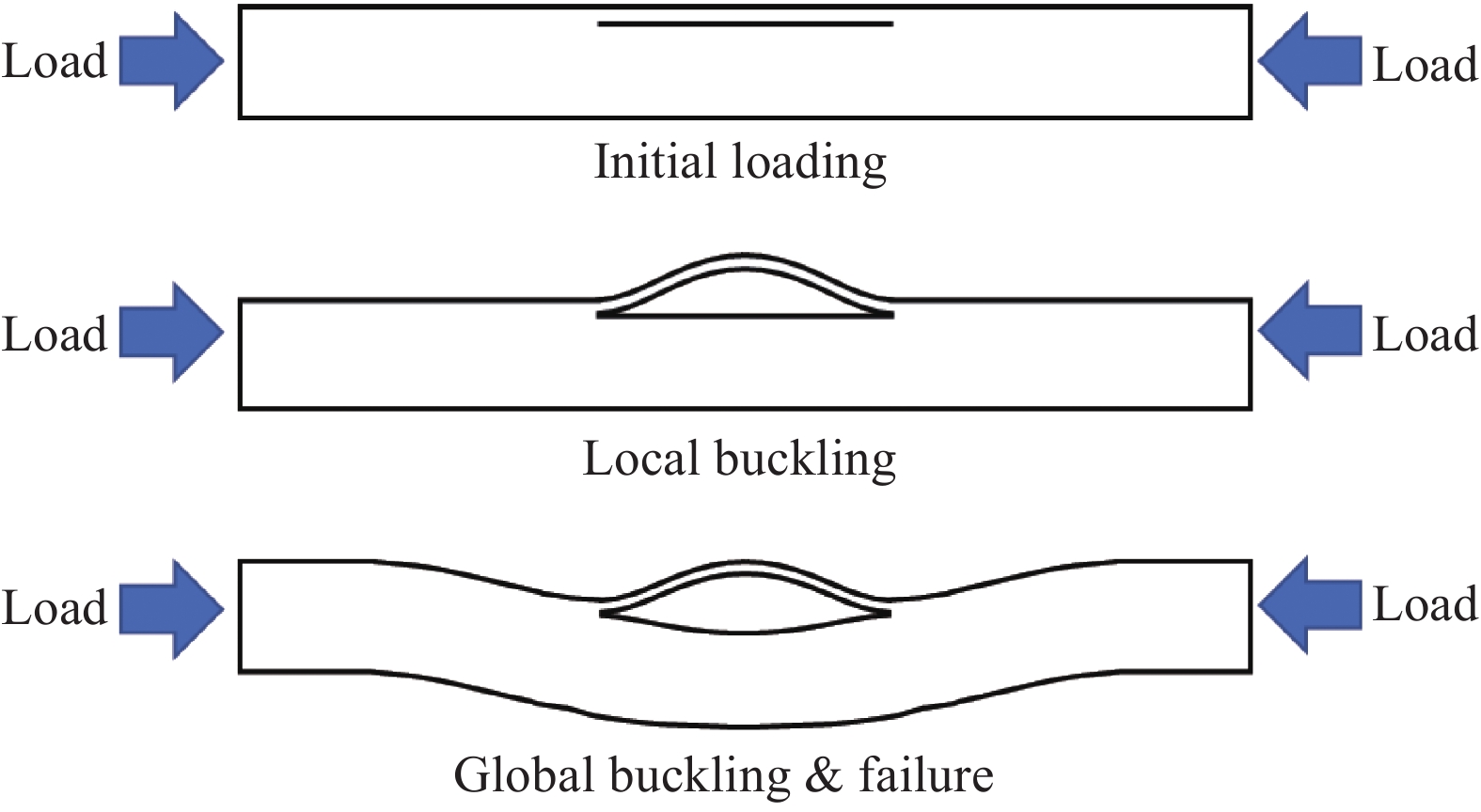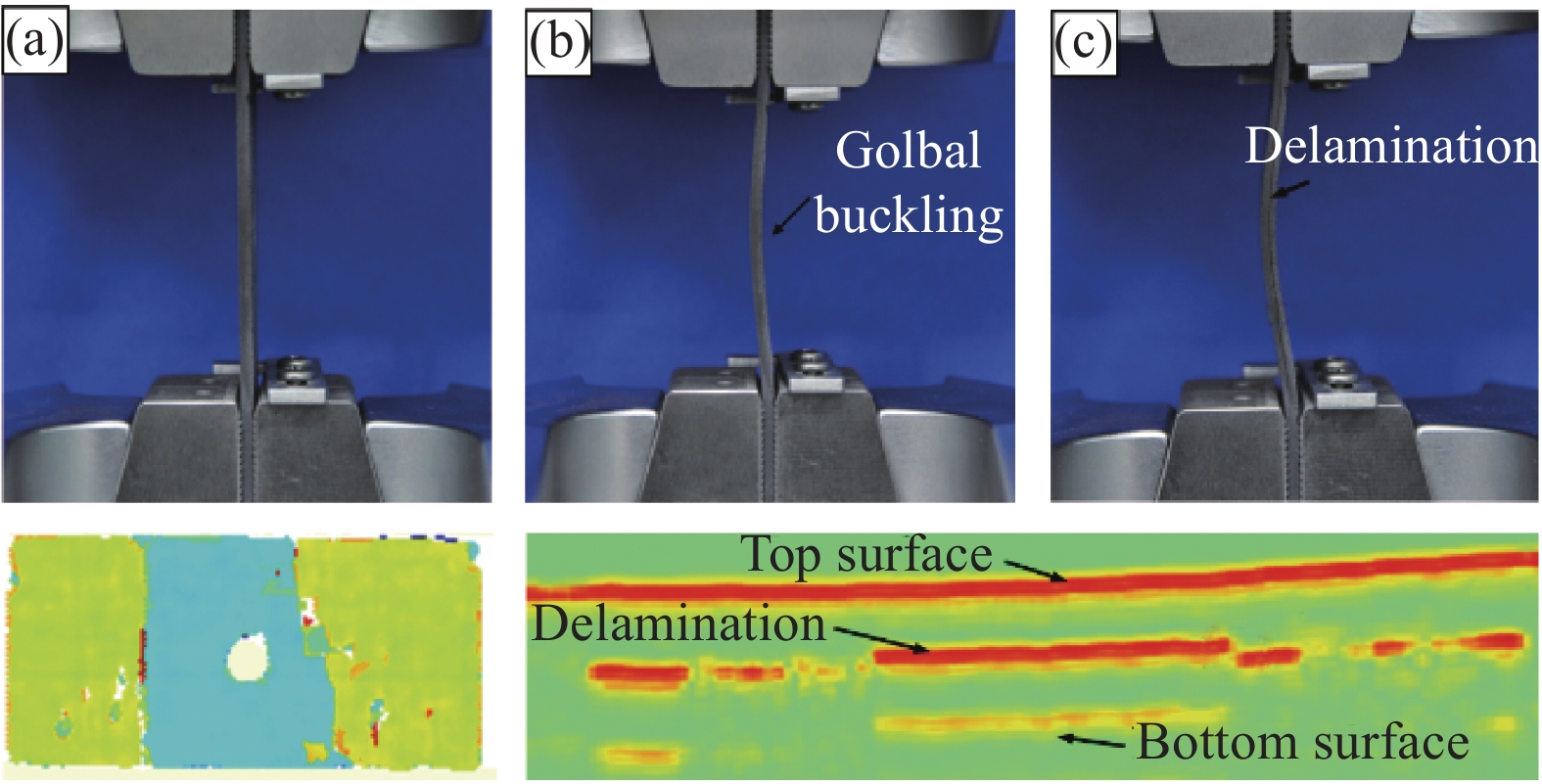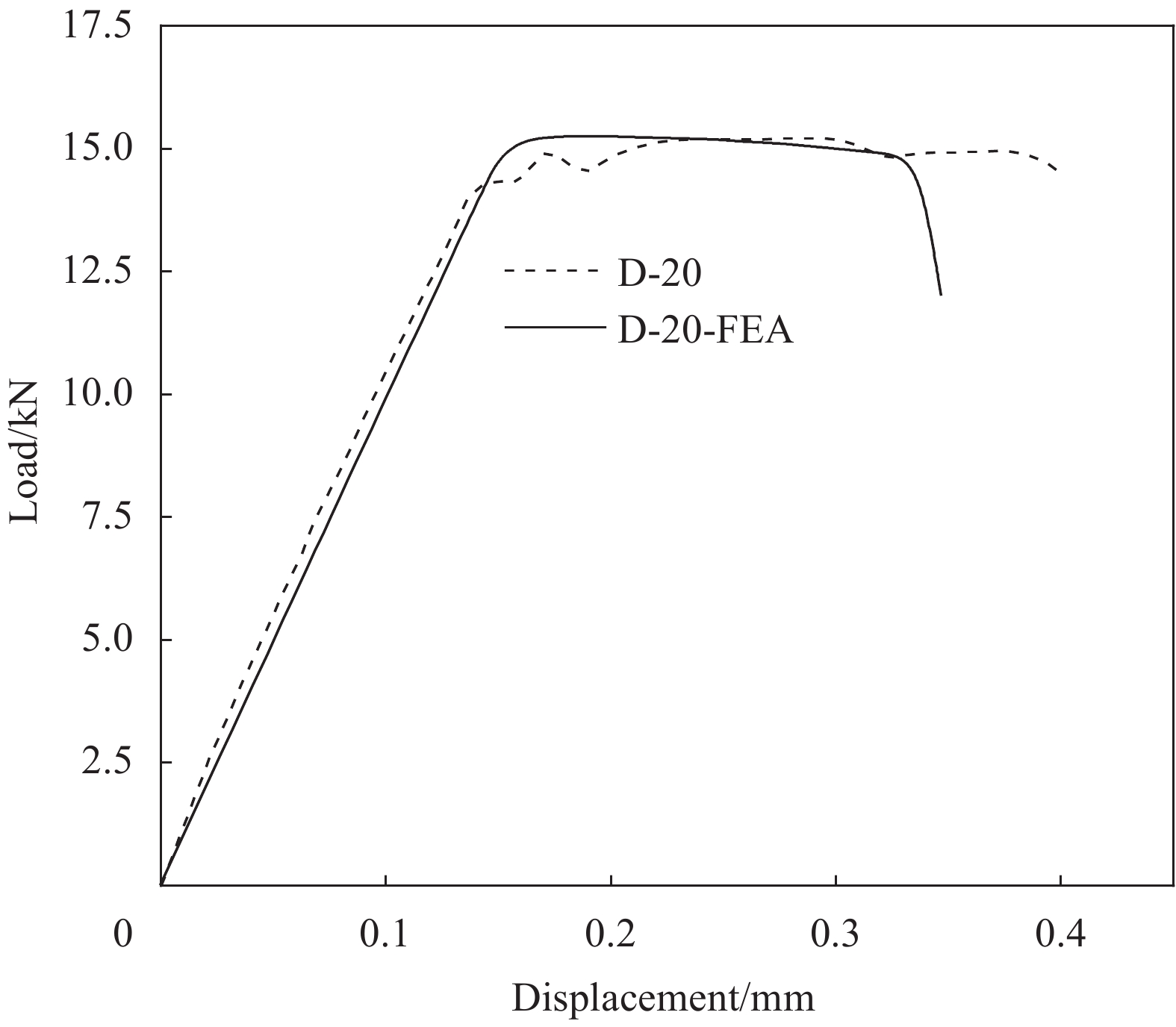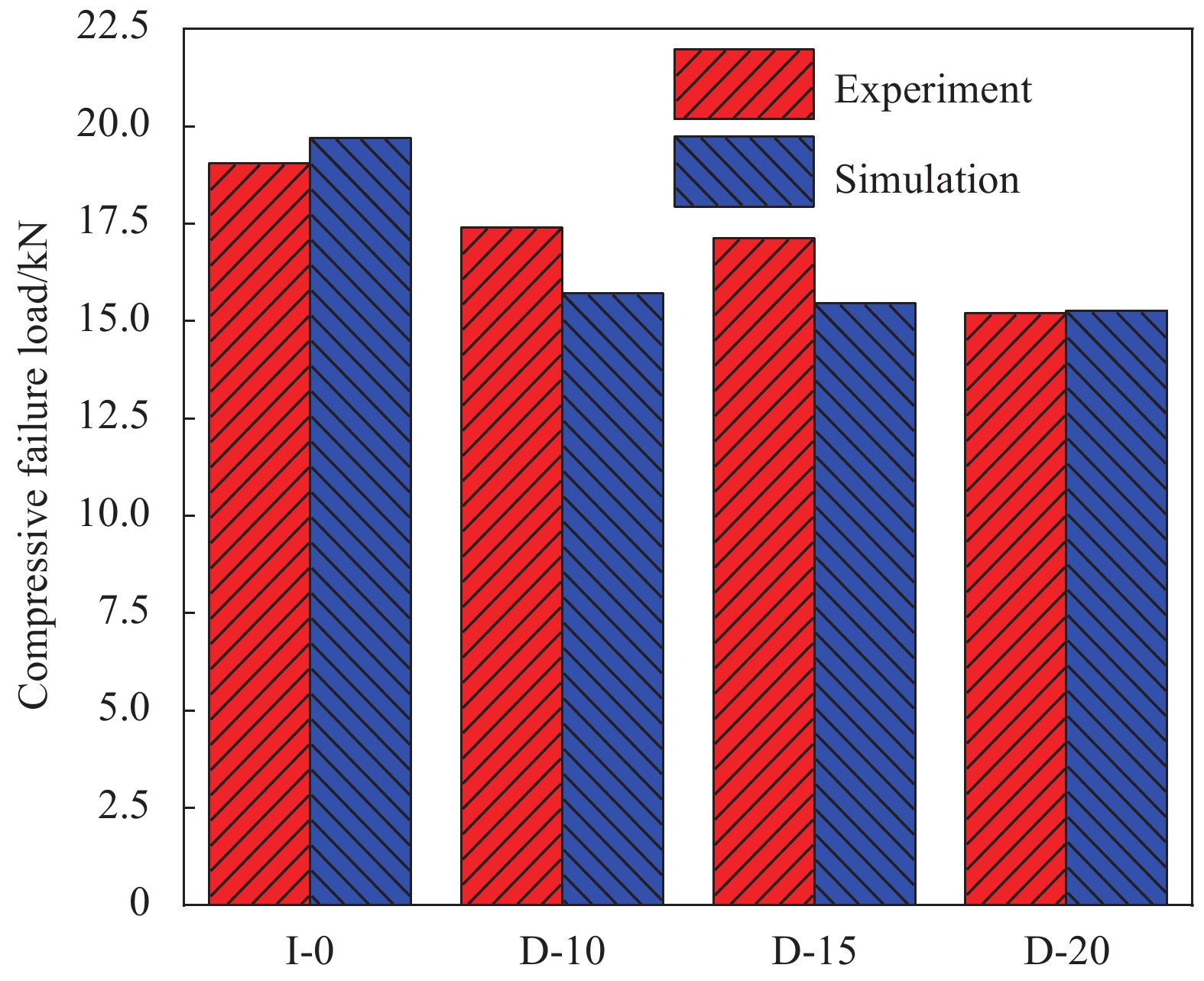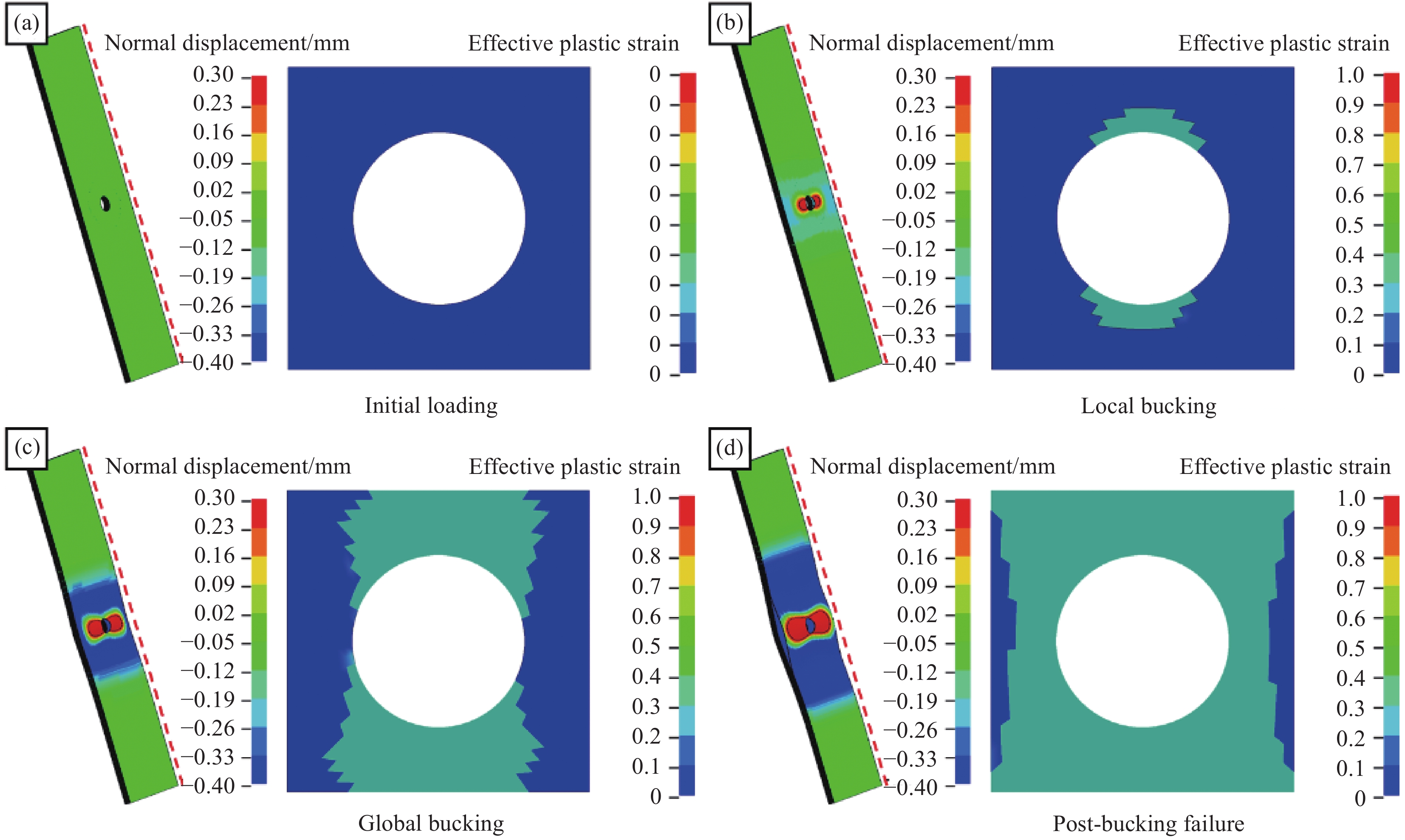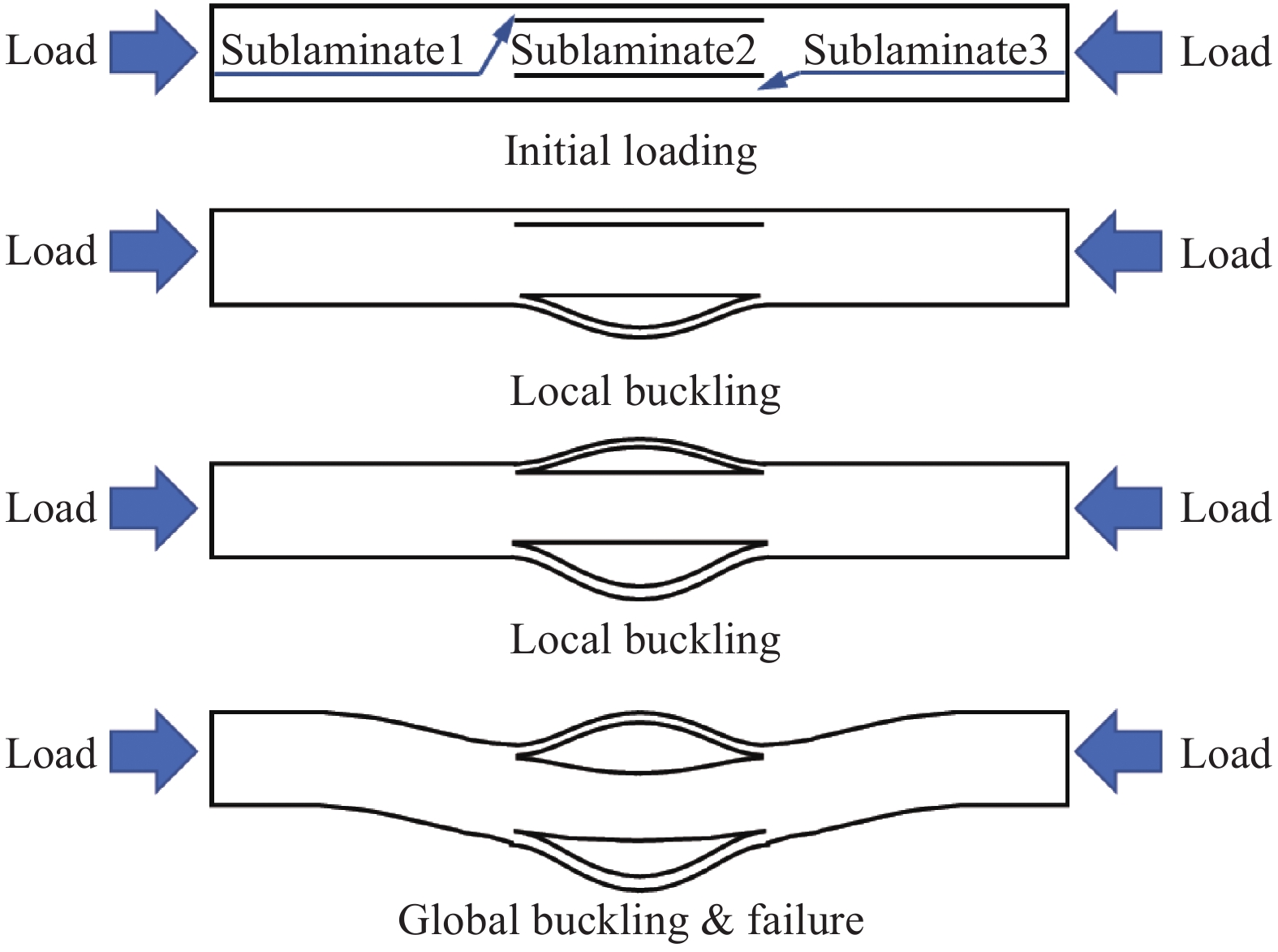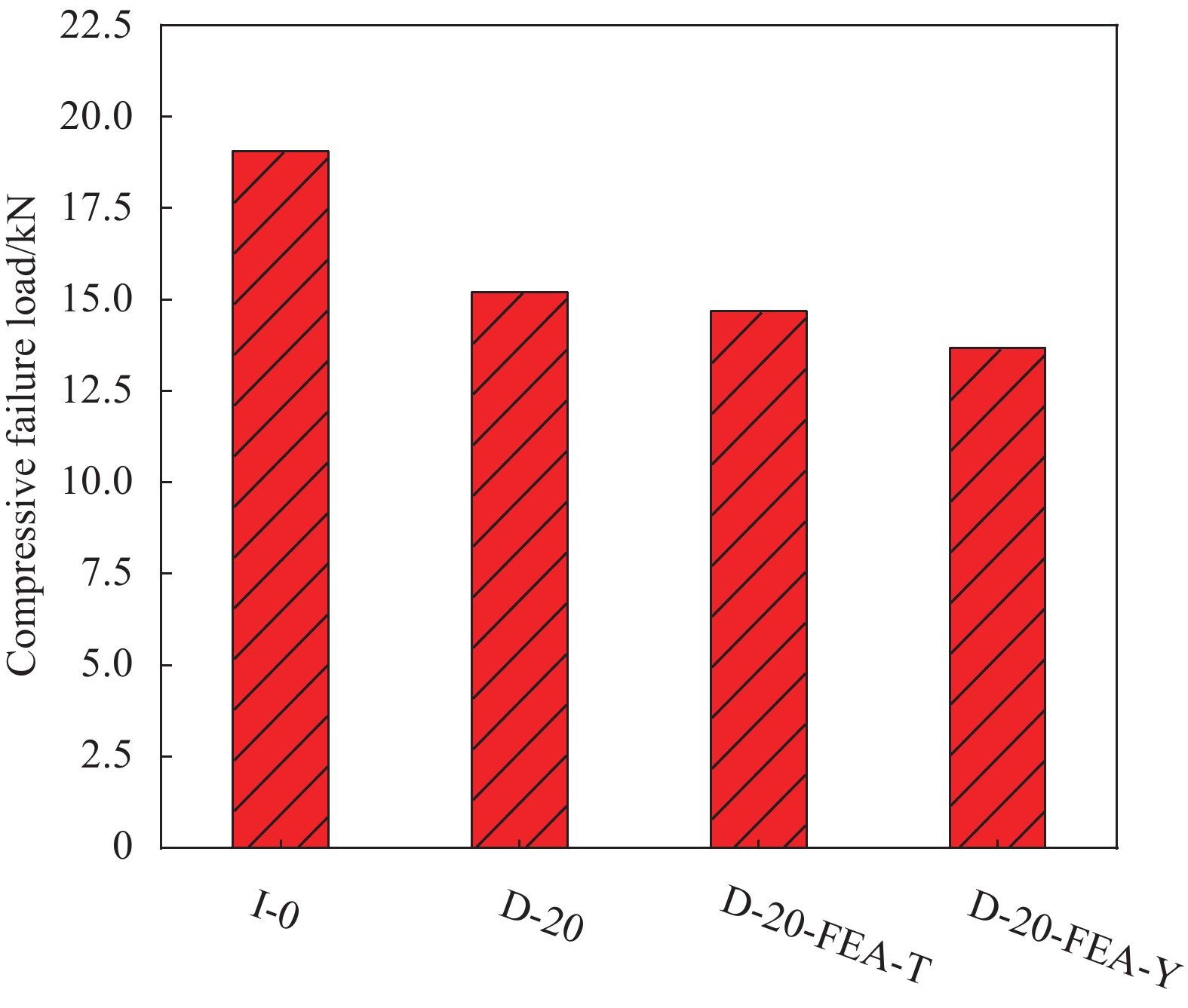Effect of drilling delamination on compressive mechanical behaviour of open-hole laminates
-
摘要: 钻孔分层损伤对复合材料层合孔板的承载能力和失效模式有着显著的影响。通过实验和仿真相结合的方式,开展单一预制分层缺陷下、双分层缺陷同侧耦合及双分层缺陷异侧耦合作用下复合材料层合孔板的压缩承载能力及失效模式的研究。通过预埋聚四氟乙烯薄膜,制备了含单一圆形预制分层缺陷的碳纤维增强树脂复合材料开孔板试件,采用浸没式超声C扫和数字图像DIC技术分别对复合材料层合板损伤和法向变形进行检测,研究含不同尺寸预制分层开孔层合板在压缩载荷下的分层扩展及失效变形特征,进而揭示分层缺陷大小对其承载能力的影响机制。构建基于内聚力单元方法的含孔复合材料层合板数值模型,对比实验修正模型,探索了单一预制分层缺陷下碳纤维增强树脂复合材料开孔板的损伤扩展机制,并在此模型基础上开展双分层缺陷耦合作用下复合材料开孔板在压缩载荷作用下的屈曲变形、分层扩展和承载能力的数值预测和分析。实验结果表明:含单一圆形预制分层缺陷的碳纤维增强环氧树脂复合材料开孔层合板试件呈现出初始受压、局部屈曲、整体屈曲后破坏的失效模式,预制分层缺陷对复合材料孔板压缩力学性能有显著影响,随着缺陷的增大压缩承载能力逐渐下降。双分层缺陷耦合作用数值分析表明:双分层缺陷进一步降低了复合材料孔板压缩承载能力,同侧非对称耦合分层缺陷结构的失效模式与单一缺陷结构基本一致,而异侧非对称耦合分层缺陷结构出现了双裂纹扩展,该裂纹扩展模式进一步削弱了孔板的压缩承载能力。Abstract: The delamination damage has significant influence on the bearing capacity and failure mode of open-hole laminates. By combining experiment and simulation, the compression bearing capacity and failure mode of composite open-hole laminates with single prefabricated laminated defects, two laminated coupling defects on the same side and double laminated coupling defects on the different side were studied. Through the embedded polytetrafluoroethylene (PTFE) membrane, the open-hole laminate containing single prefabricated delamination defects was prepared. By means of immersion ultrasonic C scan and digital image DIC technique, the damage evolution and normal deformation were characterized and monitored. The delamination propagation behavior and failure deformation characteristics of laminates with various defect sizes under compression loading were studied, and the influence mechanism of the size of the delamination defects on the bearing capacity of the laminates was revealed. A numerical model of open-hole laminate was established based on the cohesion element method. The damage propagation mechanism of open-hoe laminate with single prefabricated laminated defects was explored. Based on the optimized model, the numerical prediction and analysis of the buckling deformation, delamination expansion and bearing capacity of the open-hole laminate with two delaminated coupling defects were carried out. The experimental results show that the specimen with single delamination defect presents the initial compression, local buckling and overall buckling. The delamination size has significant impact on the compressive capability, which decreases with the increasing of delamination size. The numerical results of two delaminated defects show the second delaminated defect further reduces the compressive bearing capacity. The failure model of laminate with two coupling defects on the same sides is similar with that of laminates with single prefabricated defect; while, double-crack propagation occurs in the asymmetrical coupled laminated structure on the opposite side, which further weakens the compression bearing capacity of open-hole laminates.
-
由于石油资源不可再生,生物基的食品包装材料引起了学术界和工业界的广泛关注。尼龙612 (PA612)是一种半结晶性热塑性聚合物,可由单体己二胺和十二碳二酸缩聚而成,其中十二碳二酸可以从植物油中获得,因此PA612属于半生物基材料[1]。在包装领域,尼龙通常作为软包装应用,其具备优异的力学、耐穿刺、光学、阻隔、耐化学溶剂等综合性能[2]。在尼龙包装薄膜中,尼龙6 (PA6)薄膜应用最广,而PA612与PA6在结构性能上有一定的相似性,且较PA6具有更低的吸湿率和更好的尺寸稳定性[3]。细菌的滋生不仅影响食品新鲜度,还直接影响人体健康,因此尼龙抗菌包装材料的研究与开发受到了普遍重视[4-6]。各种类型的无机抗菌剂,如银类抗菌剂、钛类抗菌剂、锌类抗菌剂、铜类抗菌剂已经开发出来,在PA复合材料上表现出不同程度的抗菌效果[7-12]。
纳米氧化锌(以下简称ZnO)由于其较低的成本、无毒、对环境友好及优异的抗菌性能,被认为是一种有前景的抗菌剂[13]。此外,ZnO已被美国食品和药物管理局(FDA)列为公认安全(GRAS)的材料。目前,针对ZnO纳米颗粒提出的抗菌机制主要有4个方面,即活性氧ROS的生成、Zn2+的离子释放、表面静电相互作用和纳米粒子的内化[14]。Wang等[10]利用原子层沉积(ALD)与水热技术相结合制备了抗菌PA6-ZnO多级纳米纤维,发现其可有效抑制细菌存活。Li等[15]通过熔融共混和热压成型工艺制备纳米氧化锌/高密度聚乙烯(HDPE)复合薄膜并研究其机械和抗菌性能发现,通过添加纳米ZnO颗粒,提高了HDPE薄膜的拉伸强度和断裂伸长率。 ZnO/HDPE纳米复合材料表现出良好的抗菌活性,尤其是对金黄色葡萄球菌。Kim等[16]采用溶液法制备了聚乳酸(PLA)/ZnO纳米复合薄膜,其对金黄色葡萄球菌和大肠杆菌显示出明显的抗菌活性,但具有超过3wt%ZnO含量的生物纳米复合膜由于团聚和分散性差导致表面粗糙和结晶度降低。因此,为充分发挥ZnO的抗菌特性和纳米效应,同时提高其在聚合物基体中的分散性,需要对其进行表面改性。
γ-氨丙基三乙氧基硅烷偶联剂(KH550)是常用的改性剂,能有效改善纳米粒子在基体中的分散。Li等[17]采用KH550对氧化锌纳米粒子进行改性,发现纳米颗粒的分散性得到了很大的改善,有效地打破了纳米颗粒的团聚现象。截止目前,针对KH550改性纳米ZnO做为抗菌剂在PA612薄膜中应用的相关研究尚未开展。
本文利用KH550湿法改性纳米ZnO (m-ZnO),然后将m-ZnO加入到PA612基体材料中,通过双螺杆挤出造粒制备了纳米抗菌复合材料,通过挤出流延制备了PA612纳米抗菌复合薄膜。研究了m-ZnO对纳米复合材料热稳定性、结晶行为、力学性能和抗菌性能的影响。
1. 实验材料及方法
1.1 原材料
实验选用的PA612 (Zytel® 151L NC010)熔点为218℃,购自杜邦公司;纳米氧化锌(ZnO),粒径50 nm,上海阿拉丁生化科技股份有限公司;硅烷偶联剂KH550,分子量为221.37 g/mol,安徽泽升科技有限公司;溶菌肉汤(LB肉汤)、琼脂粉,青岛高科技工业园海博生物技术有限公司;大肠杆菌(ATCC25922)、金黄色葡萄球菌(ATCC29213),上海鲁微科技有限公司。
1.2 m-ZnO/PA612纳米复合材料的制备
利用偶联剂KH550对纳米氧化锌进行改性。将20 g纳米ZnO和500 mL 95%乙醇加入到1000 mL的三口烧瓶中,超声分散30 min,然后搅拌加热至75℃。将2 g KH550预水解1 h后缓慢加入到ZnO溶液中,在75℃下搅拌4 h后终止反应。然后将所得混合物抽滤分离,并用乙醇洗涤3次,以去除过量的KH550。将表面改性的纳米氧化锌(m-ZnO)在真空干燥箱中60℃干燥12 h,最后研磨成粉末备用。
采用熔融复合法制备了含m-ZnO纳米颗粒的PA612纳米复合材料。将所需含量的m-ZnO与PA612在双螺杆挤出机(CTE 35 PLUS,南京科倍隆机械有限公司)中在250℃下熔融共混挤出,然后用流延机(FDHU-35,广东市普同实验分析仪器)以20 r/min的固定转速在270℃下流延成膜,流延膜厚度为(120±10) μm。所制备的m-ZnO/PA612纳米复合材料简称Xm-ZnO/PA612。为了比较,以同样的步骤,将原始的ZnO纳米颗粒与PA612混合,所制备的ZnO/PA612纳米复合材料简称XZnO/PA612,其中X为纳米复合材料中ZnO的质量分数。复合薄膜具体质量配比如表1所示。
表 1 不同ZnO含量的ZnO/PA612抗菌复合膜Table 1. ZnO/PA612 antibacterial composite films with different ZnO contentSample Mass fraction/wt% PA612 m-ZnO ZnO PA612 100 0 0 0.5wt%m-ZnO/PA612 99.5 0.5 0 2wt%
ZnO/PA61298 0 2 2wt%m-ZnO/PA612 98 2 0 4wt%m-ZnO/PA612 96 4 0 6wt%m-ZnO/PA612 94 6 0 Notes: m-ZnO—Modified nano zinc oxide; ZnO—Unmodified nano zinc oxide; PA612—Nylon 612. 1.3 改性ZnO和ZnO/PA612复合膜的表征
傅里叶变换红外光谱(FTIR)测试:采用Bruker TENSOR II型红外光谱仪进行测试,扫描范围为4000~400 cm−1,波数分辨率为4 cm−1。
扫描电子显微镜(SEM)和能量色散X射线能谱(EDX)测试:先将样品在液氮中低温脆断后贴于导电胶,然后将样品在真空条件下喷金,再排布在样品台上观察,电压3 kV。
差示扫描量热仪(DSC)测试:采用德国耐驰公司的DSC214型差式扫描量热仪,取5~10 mg样品,在N2氛围下将样品由25℃加热至280℃,保持5 min去除热历史后降至25℃,各阶段升温速率均为10℃/min。结晶度由下式计算:
Xc=ΔHm(1−wf)ΔH0×100% (1) 其中:∆Hm为熔融焓;wf为m-ZnO的质量分数;∆H0为PA612结晶度为100%对应的熔融焓(258 J/g)[18]。
X射线衍射仪(XRD)测试:采用日本理学的UltimaIV型X射线衍射仪,反射模式,铜靶,管电压为40 kV,管电流为30 mA,测试范围为5°~30°,扫描速率为2°/min。
热重分析仪(TGA):美国TA仪器公司Q20型,在氮气气氛下进行,试样以10℃/min的升温速率从30℃加热到600℃。
力学性能测试:采用深圳万测实验设备有限公司的ETM-104B型万能力学试验机,通过哑铃裁刀,将薄膜裁为长35 mm、窄部宽2 mm的哑铃型样条。测试前把样条放置在23℃、相对湿度为50%的条件下恒温恒湿处理48 h,测试速度为50 mm/min,取5根样条结果的平均值。
光学测试:采用上海精密科学仪器有限公司的WGT-S透光度雾度测试仪,参照国家标准GB/T 2410—2008[19],测量薄膜的透光率和雾度。
抗菌活性检测:采用贴膜平板计数法测试样品抗菌率,参照国家标准GB/T 31402—2015[20]。样品处理:将样品裁成5 cm×5 cm大小,覆盖膜裁成4 cm×4 cm大小,先于酒精中浸泡30 min,然后取出放于紫外灯下两面各照射灭菌 30 min,备用。菌液准备:取活化后的菌液10 μL于30 mL液体培养基中,在恒温振荡器上培养16 h后,将菌液稀释约至105 CFU/mL的浓度。共培养:将试样放入无菌培养皿中,用移液管吸取0.4 mL菌液,滴到每个试样表面,并将覆盖膜盖于接种好的菌液上,并向下轻轻按压使菌液均匀扩散,然后盖上培养皿盖,在35℃恒温培养箱中培养24 h。共培养完成后,采用0.85%生理盐水清洗薄膜并进行10倍倍比稀释(本测试采用103、104和105 稀释倍数),各取100 μL稀释液均匀涂布于LB固体培养基,即倒平板,放于35℃恒温培养箱中静置培养24 h,拍照并记录菌落数。抗菌率计算:
R=A−BA×100% (2) 其中:R为抗菌率;A为空白样菌浓度(未加抗菌剂的纯PA612薄膜);B为样品的菌浓度。菌浓度(CFU/mL)计算方式:菌落数×稀释倍数×10 (0.1 mL涂布)。
2. 结果与讨论
2.1 ZnO/PA612 复合膜的结构与形貌
ZnO和m-ZnO的FTIR图谱如图1所示,在ZnO图谱中,3000~3700 cm−1处的宽峰对应—OH的伸缩振动,1636 cm−1处的宽峰代表纳米颗粒表面吸附的水分子导致的—OH的弯曲振动,在500 cm−1附近检测到的峰,归因于Zn—O的伸缩振动[21]。 两个新峰2975 cm−1和2931 cm−1对应于KH550的碳氢拉伸振动峰。1016 cm−1处的峰是KH550醇解后羟基与纳米氧化锌表面的羟基缩合反应产生的Si—O—Zn拉伸振动峰[22]。上述结果表明KH550成功接枝到纳米氧化锌上。
进一步地,可以通过SEM图像,直观评估m-ZnO/PA612纳米复合材料中纳米颗粒的分散,如图2所示,其中插入的图片为m-ZnO/PA612纳米复合材料的外观照片,可以看出,纳米ZnO包覆在薄膜内部。从SEM图像中可以看出 2wt%ZnO/PA612 (含2wt%未改性ZnO)表现出明显的颗粒团聚。与 2wt%ZnO/PA612相比,改性ZnO颗粒在PA612基体中的分散性要好得多。然而,m-ZnO的添加量相对较高(4wt%和6wt%)时,由于纳米颗粒的大比表面积,在断裂表面出现了轻微的团聚(图中圆圈)。综上所述,偶联KH550可以有效提高纳米ZnO 在PA612基体中的分散性,但随着 m-ZnO 含量增加至4wt%,纳米颗粒会部分团聚。
2wt%m-ZnO/PA612的SEM图像如图3所示,对应的EDX光谱证实了2wt%m-ZnO/PA612的化学成分,在锌元素和氧元素处有两个尖锐的信号峰。此外,还观察到氮和硅元素的信号峰,这可能是由于接枝KH550的存在,这也印证了KH550的成功接枝。从图3中的EDX映射图像可以看出,Zn元素分布均匀,表明m-ZnO均匀地分布在纳米复合膜中。
2.2 ZnO/PA612复合膜的结晶性能
图4显示了PA612及其纳米复合材料的熔融结晶行为。图4(a)中m-ZnO/PA612纳米复合材料的熔融峰温度(Tm)与纯PA612相比都略微下降。从图4(b)中可以观察到m-ZnO/PA612纳米复合材料的结晶峰温度(Tc)都向较高的值移动。这些结果表明,在结晶过程中,m-ZnO的存在有助于促进晶体的成核。
表2列出了PA612及其纳米复合材料的Tc、Tm、熔融焓(∆Hm)、结晶度(Xc)。可见,m-ZnO/PA612纳米复合材料的结晶度均高于纯PA612,在m-ZnO添加量为2wt%时,其结晶度相较于纯PA612提高了4.1%,可见m-ZnO的加入可以促进PA612结晶,这是由于m-ZnO具有异相成核的作用[23]。然而,m-ZnO/PA612纳米复合材料的结晶度随m-ZnO含量的增加先增大后有所下降。这是由于随着m-ZnO含量增大,产生了部分团聚,降低了其成核作用[24]。
表 2 PA612及不同m-ZnO含量的PA612纳米复合材料的DSC热分析数据Table 2. DSC thermal analysis data of PA612 and PA612 nanocomposites with different m-ZnO contentsSample Tm/℃ Tc/℃ ΔHm/(J·g−1) Xc/% PA612 222.86 186.26 61.22 23.73 0.5wt%m-ZnO/PA612 220.37 187.09 70.68 27.53 2wt%m-ZnO/PA612 221.67 187.34 70.36 27.83 4wt%m-ZnO/PA612 221.29 186.99 66.99 26.93 6wt%m-ZnO/PA612 220.97 186.14 65.61 26.88 Notes: Tm—Melting peak temperature; Tc—Crystallization peak temperature; △Hm—Melting enthalpy; Xc—Crystallinity. m-ZnO/PA612纳米复合材料的XRD图谱如图5所示。PA612中观察到2θ=21°的衍射峰,对应于PA612的γ晶型[25]。与纯PA612相比,m-ZnO/PA612纳米复合材料的衍射峰没有明显的位移或变化,表明m-ZnO的加入对PA612的晶型结构没有影响。
2.3 ZnO/PA612复合膜的热稳定性能
通过热重分析(TGA)研究了m-ZnO含量对PA612热稳定性的影响,结果如图6所示。m-ZnO的加入对PA612纳米复合材料的热稳定性没有很大的影响。
表3列出了失重分别为5wt% (T5%)和 50wt% (T50%)时的温度及600℃ 时的残炭率。可以发现T5%几乎没有变化,表明无论 m-ZnO 含量如何,所有 PA612 纳米复合材料的热稳定性都较好。在PA612 基体中添加m-ZnO 后,T50%温度向较低温度移动。热稳定性的降低可能与高温下ZnO在增强型基质上的催化活性有关[26]。此外,ZnO 纳米粒子可以诱导聚合物-ZnO界面中周围碳的氧化分解[27]。随着m-ZnO 含量的增加,m-ZnO/PA612纳米复合材料在 600℃的炭产率逐渐增加。
表 3 PA612及不同m-ZnO含量的PA612纳米复合材料的热稳定性Table 3. Thermal stability of PA612 and PA612 nanocomposites with different m-ZnO contentsSample T5%/℃ T50%/℃ Char yield at 600℃/wt% PA612 398.9 450.0 2.3 0.5wt%m-ZnO/PA612 400.4 446.0 2.7 2wt%m-ZnO/PA612 397.2 443.0 3.5 4wt%m-ZnO/PA612 399.3 446.7 4.7 6wt%m-ZnO/PA612 398.6 446.3 7.8 Notes: T5% and T50%—Temperature when the weight loss of the samples is 5wt% and 50wt%, respectively. 2.4 ZnO/PA612复合膜的力学性能
PA612及其纳米复合材料的典型应力-应变曲线如图7所示。表4总结了拉伸应力、杨氏模量和断裂伸长率。可以看出所有试样的应力-应变曲线分为弹性、塑性变形和应变硬化3个区域。首先弹性区域具有可恢复变形的线性变化,在塑性变形区将形成颈部。随后应变硬化区出现应变硬化的现象。可见纳米氧化锌作为刚性填料改变了基体的应力场。
当添加2wt%m-ZnO时,m-ZnO/PA612纳米复合材料的拉伸强度达到最大值,与纯PA612相比提高了15%。随后拉伸强度有所下降。这是由于纳米氧化锌极高的表面能,当含量较高时,由于其较强的相互吸附作用,导致出现明显的团聚现象(图3),从而降低了m-ZnO/PA612势同拉伸强度一样,在m-ZnO含量为2wt%达到最大。m-ZnO/PA612纳米复合材料的断裂伸长率较PA612略有下降。这是由于纳米ZnO提高了m-ZnO/PA612纳米复合材料的结晶度,使材料变脆,此外m-ZnO在m-ZnO/PA612基体中会引起应力集中,从而使其韧性变差。
2.5 ZnO/PA612复合膜的光学性能
m-ZnO/PA612纳米复合膜的透光率和雾度如图8所示。随着m-ZnO含量的增加,复合膜的透光率随之降低,雾度与之相反,这是由于纳米氧化锌在基体中团聚,会影响光的传输,从而产生光散射,导致透光率的降低。
2.6 ZnO/PA612复合膜的抗菌性能
m-ZnO/PA612纳米复合膜对大肠杆菌的抗菌活性如图9所示,抗菌率数据列于表5。结果表明:m-ZnO的加入使PA612纳米复合材料具有抗菌活性。此外,随着m-ZnO含量的增加,抗菌率逐渐增大,在m-ZnO含量达到4wt%时,其抗菌率达到93.25%。这些结果可以归结为纳米氧化锌具有优越的抗菌性能。对于ZnO抗菌机制的研究比较成熟,主要解释为两种,金属离子溶出机制和光催化反应机制[28]。当有紫外光照射时,会在ZnO纳米结构的表面形成电子空穴对,这些电子和空穴经过与水分子和氧分子反应生成活性氧,能降解大多数微生物中的有机物,从而杀死细菌,而ZnO粒径大小决定了光催化反应效率,其抗菌活性随粒径减小而增大。2wt%ZnO/PA612在尼龙基体中团聚使其相对粒径增大,2wt%m-ZnO/PA612在尼龙基体中较2wt%ZnO/PA612分散更好,从而使其抗菌效果更佳。因此2wt%m-ZnO/PA612对大肠杆菌的抗菌率远远大于2wt%ZnO/PA612。
表 4 PA612及不同m-ZnO含量的PA612纳米复合材料的拉伸性能Table 4. Tensile properties of PA612 and PA612 nanocomposites with different m-ZnO contentsSample Tensile stress/MPa Young’s modulus/MPa Elongation at break/% PA612 93.95±5.55 685.11±50.97 392.77±13.70 0.5wt%m-ZnO/PA612 93.06±4.56 543.66±39.20 378.30±11.08 2wt%m-ZnO/PA612 108.13±1.76 889.70±60.78 305.23±10.13 4wt%m-ZnO/PA612 84.31±8.35 422.97±94.12 371.85±27.97 6wt%m-ZnO/PA612 83.06±10.85 486.79±71.10 325.38±32.66 表 5 PA612及不同m-ZnO含量的PA612纳米复合材料膜对大肠杆菌的抑菌活性Table 5. Antibacterial activity of PA612 and PA612 nanocomposites with different m-ZnO contents membranes against Escherichia coliSample Bacteria concentration/
(CFU·mL−1)Antibacterial rate R/% PA612 5.48×106 0.00 0.5wt%m-ZnO/PA612 3.89×106 29.01 2wt%ZnO/PA612 1.43×106 73.91 2wt%m-ZnO/PA612 5.30×105 90.33 4wt%m-ZnO/PA612 3.70×105 93.25 6wt%m-ZnO/PA612 2.50×105 95.44 m-ZnO/PA612纳米复合膜对金黄色葡萄球菌的抗菌活性如图10所示,抗菌率数据列于表6。结果表明:同纳米抗菌复合膜对大肠杆菌的抗菌活性相似,随着m-ZnO含量的增加,m-ZnO/PA612纳米复合膜对金黄色葡萄球菌的抗菌率逐渐增大,在m-ZnO含量达到4wt%时,其抗菌率达到90%以上,在m-ZnO含量较高时,m-ZnO/PA612纳米复合薄膜对大肠杆菌的抑菌效果优于金黄色葡萄球菌。这可能是由于革兰氏阳性菌金黄色葡萄球菌的肽聚糖膜比革兰氏阴性菌大肠杆菌厚得多[29]。
表 6 PA612及不同m-ZnO含量的PA612纳米复合材料膜对金黄色葡萄球菌的抑菌活性Table 6. Antibacterial activity of PA612 and PA612 nanocomposites with different m-ZnO contents membranes against Staphylococcus aureusSample Bacteria concentration/
(CFU·mL−1)Antibacterial
rate R/%PA612 5.35×106 0.00 0.5wt%m-ZnO/PA612 3.60×106 32.71 2wt%ZnO/PA612 1.73×106 67.66 2wt%m-ZnO/PA612 9.40×105 82.43 4wt%m-ZnO/PA612 4.80×105 91.03 6wt%m-ZnO/PA612 3.60×105 93.27 3. 结 论
(1) 利用γ-氨丙基三乙氧基硅烷偶联剂(KH550)改性纳米ZnO颗粒(m-ZnO),SEM观察发现未改性纳米ZnO在尼龙612 (PA612)基体中出现较大团聚,而m-ZnO纳米粒子在PA612基体中均分散良好。
(2) m-ZnO作为成核剂可以促进PA612的结晶,m-ZnO添加量为2wt%时,结晶度提高了4.1%。m-ZnO的存在对PA612热稳定性的影响较小。
(3) 适量m-ZnO的加入对PA612有增强作用,在m-ZnO添加量为2wt%时,PA612纳米复合材料的拉伸强度较纯PA612提高了15%。
(4) m-ZnO的加入使PA612对革兰氏阳性菌金黄色葡萄球菌和革兰氏阴性菌大肠杆菌都具有抗菌活性,在m-ZnO添加量超过4wt%时,对金黄色葡萄球菌和大肠杆菌的抗菌率均达到90%以上。
(5) 通过挤出流延法制得的半生物基PA612纳米复合抗菌薄膜不但具有良好的抗菌性能和热稳定性能,且力学性能优良,加工工艺简单,有利于工业化生产,在食品、药品等包装领域有一定的应用前景。
-
图 2 单一预制分层缺陷的CF/EP开孔层合板模型示意图
Figure 2. Schematic diagram of CF/EP open-hole laminates with a single prefabricated lamination defect
L0—Total length of laminate; L1—Length of clamping end; b—Width of laminate; D—Diameter of prefabricated defect; d—Diameter of open-hole; t—Thickness of laminates; PTFE—Polytetrafluoroethylene
图 6 双线性内聚力单元损伤模型示意图
Figure 6. Diagram of bilinear cohesive damage model
Ti—Traction force of laminates during type i fracture; Kp—Penalty stiffness; δi—Displacement response under type i traction; δi0—Crack opening displacement corresponding to the maximum stress; σmax—Maximum normal stress value; τmax—Maximum tangential stress
表 1 CF/EP开孔层合板详细尺寸
Table 1 Detailed dimensions of CF/EP open-hole laminates
Type L0/mm L1/mm b/mm D/mm d/mm t/mm I-0 135 30 35 − 6 2.6 D-10 135 30 35 10 6 2.6 D-15 135 30 35 15 6 2.6 D-20 135 30 35 20 6 2.6 Notes: I—Defect-free porous composite plate; The number after the letter D is the diameter of the damaged area. 表 2 CF/EP预浸料材料属性及参数
Table 2 Material properties and parameters of CF/EP prepreg
Parameter Value E11/MPa 144700 E22/MPa 9650 E33/MPa 9650 G12/MPa 5800 G13/MPa 5800 G23/MPa 4800 ν12 0.3 ν13 0.3 ν23 0.45 Notes: E—Elastic modulus; ν—Poisson's ratio; G—Shear modulus; 1—Direction of fiber; 2—Direction of matrix; 3—Thickness direction of layer; Xt—Longitudinal tensile strength; Xc—Longitudinal compressive strength; Yt—Transverse tensile strength; Yc—Transverse compressive strength; S—In-plane shear strength. 表 3 双缺陷耦合作用下CF/EP开孔层合板压缩屈曲数值模拟结果(D-20-FEA-T)
Table 3 Numerical simulation results of compression buckling of CF/EP open-hole laminates under the coupling action of double defects (D-20-FEA-T)
State 1 2 3 4 Sublaminate 1 



Sublaminate 2 



表 4 双缺陷耦合作用下CF/EP开孔层合板压缩屈曲数值模拟结果(D-20-FEA-Y)
Table 4 Numerical simulation results of compression buckling of CF/EP open-hole laminates under the coupling action of double defects (D-20-FEA-Y)
State 1 2 3 4 5 Sublaminate 1 




Sublaminate 3 




-
[1] FREITAS M D, CARVALHO R D. Residual strength of a damaged laminated CFRP under compressive fatigue stresses[J]. Composites Science & Technology,2006,66(3-4):373-378.
[2] TAFRESHI A, OSWALD T. Global buckling behaviour and local damage propagation in composite plates with embedded delaminations[J]. International Journal of Pressure Vessels& Piping,2003,80(1):9-20.
[3] AUERSCH L, SCHMID G. A torque and thrust prediction model for drilling of composite materials[J]. Composites Part A: Applied Science & Manufacturing,2005,36(1):83-93.
[4] KHASHABA U A, EL-SONBATY I A, SELMY A I, et al. Machinability analysis in drilling woven GFR/epoxy composites: Part I-Effect of machining parameters[J]. Composites Part A: Applied Science & Manufacturing,2010,41(3):391-400.
[5] DUAN Q F, LI S X, SONG P H, et al. Effect of drilling-induced delamination on buckling behavior of open hole composite laminate specimens under compressive loading[J]. Strength of Materials,2019,51:624-632.
[6] HAN P K, WHITEHEAD R S, KAUTZ E F. Damage tolerance certification methodology for composite structures[C]. Eighth DOD(NASA)FAA Conference on Fibrous Compo-sites in Structural Design, Part 2. NASA. Langley Research Center, 1990.
[7] MCGOWAN D M, AMBUR D R. Structural response of composite sandwich panels impacted with and without compression loading[J]. Journal of Aircraft,1971,36(3):596-602.
[8] KARIMI N Z, HEIDARY H, FOTOUHI M, et al. Experimental analysis of GFRP laminates subjected to compression after drilling[J]. Composite Structures, 2017, 169: 144–152.
[9] OLSSON R. Analytical prediction of large mass impact damage in composite laminates[J]. Composites Part A: Applied Science & Manufacturing,2001,32(9):1207-1215.
[10] 王雪明, 谢富原, 李敏, 等. 热压罐成型复合材料复杂结构对制造缺陷的影响规律[J]. 航空学报, 2009, 30(4):757-762. DOI: 10.3321/j.issn:1000-6893.2009.04.029 WANG Xueming, XIE Fuyuan, LI Min, et al. Effect of complex structure on manufacturing defects of composite materials formed by auto-claves[J]. Acta Aeronautica et Astronautica Sinica,2009,30(4):757-762(in Chinese). DOI: 10.3321/j.issn:1000-6893.2009.04.029
[11] KATERELOS D G, PAIPETIS A, KOSTOPOULOS V. A simple model for the prediction of the fatigue delamination growth of impacted composite panels[J]. Fatigue & Fracture of Engineering Materials& Structures,2004,27(10):911-922.
[12] ISMAIL S O, OJO S O, DHAKAL H N. Thermo-mechanical modelling of FRP cross-ply composite laminates drilling: Delamination damage analysis[J]. Composites Part B: Engineering,2017,108:45-52. DOI: 10.1016/j.compositesb.2016.09.100
[13] 张明辉, 周储伟, 鲁浩. 碳纤维复合材料单向板钻孔分层损伤的数值模拟[J]. 机械工程材料, 2019, 43(9):73-77. ZHANG Minghui, ZHOU Chuwei, LU Hao. Numerical simulation of delamination dam-age of carbon fiber composite plate in borehole[J]. Materials for Mechanical Engineering,2019,43(9):73-77(in Chinese).
[14] 唐荆, 陈啸, 杨科. 碳纤维复合材料开孔层合板压缩损伤预测和模型比较[J]. 玻璃钢/复合材料, 2019(10):33-39. TANG Jing, CHEN Xiao, YANG Ke. Compression damage prediction and model comparison of carbon fiber compo-site open-hole laminates[J]. Fiber Reinforced Plastics/Composites,2019(10):33-39(in Chinese).
[15] 温泉, 郭东明, 高航, 等. 碳纤维/环氧树脂复合材料制孔损伤综合评价方法[J]. 复合材料学报, 2016, 33(2):265-272. WEN quan, GUO Dongming, GAO Hang, et al. Comprehensive evaluation method for hole damage of carbon fiber/epoxy resin composites[J]. Acta Materiae Compositae Sinica,2016,33(2):265-272(in Chinese).
[16] 卓越, 关志东, 周睿, 等. 复合材料开孔层板压缩渐进损伤试验[J]. 复合材料学报, 2015, 32(6):1762-1768. ZHUO Yue, GUAN Zhidong, ZHOU Rui, et al. Experimental study on progressive damage of composite laminates by compression[J]. Acta Materiae Compositae Sinica,2015,32(6):1762-1768(in Chinese).
[17] OJO S O, ISMAIL S O, PAGGI M, et al. A new analytical critical thrust force model for delamination analysis of laminated composites during drilling operation[J]. Composites Part B: Engineering, 2017, 124: 207–217.
[18] 姜晓伟, 朱书华, 李国弘, 等. 含分层缺陷复合材料层合板分层扩展研究[J]. 航空计算技术, 2014, 44(5):73-76. DOI: 10.3969/j.issn.1671-654X.2014.05.018 JIANG Xiaowei, ZHU Shuhua, LI Guohong,et al. Research on layered extension of composite laminates with layered defects[J]. Aeronautical Computing Technology,2014,44(5):73-76(in Chinese). DOI: 10.3969/j.issn.1671-654X.2014.05.018
[19] NILSSON K F, ASP L E, ALPMAN J E, et al. Delamination buckling and growth for delaminations at different depths in a slender composite panel[J]. International Journal of Solids & Structures, 2001, 38(17): 3039-3071.
[20] 刘雅玲, 王康康, 赵丽滨. 含预制分层复合材料层合板的压缩失效行为研究[C]//北京力学会第二十三届学术年会会议论文集. 北京: 北京力学会, 2017: 2. LIU Yaling, WANG Kangkang, ZHAO Libin. Study on compression failure behavior of laminated plates containing precast laminated composites[C]//Proceedings of the 23rd Annual Conference of Beijing Society of Mechanics. Beijing: Beijing Society of Mechanics, 2017: 2(in Chinese).
[21] RHEAD A T, BUTLER R, HUNT G W. Compressive strength of composite laminates with delamination-induced interaction of panel and sublaminate buckling modes[J]. Composite Structures, 2017, 171: 326-334.
[22] ASTM. Standard test method for tensile properties of polymer matrix composite materials: ASTM D3039/D3039M—17[S]. West Conshohocken: ASTM International, 2017.
[23] ASTM. Standard test method for compressive properties of polymer matrix composite materials using a combined loading compression (CLC) test fixture: ASTM D6641/D6641M—16[S]. West Conshohocken: ASTM International, 2016.
[24] ASTM. Standard test method for in-plane shear response of polymer matrix composite materials by tensile test of a ±45° laminate: ASTM D3518/D3518M—18[S]. West Conshohocken: ASTM International, 2018.
[25] ELICES M, GUINEA G V, GÓMEZ J, et al. The cohesive zone model: advantages, limitations and challenges[J]. Engineering Fracture Mechanics,2002,69(2):137-163. DOI: 10.1016/S0013-7944(01)00083-2
[26] WANG R G, ZHANG L, ZHANG J, et al. Numerical analysis of delamination buckling and growth in slender laminated composite using cohesive element method[J]. Computational Materials Science, 2010, 50(1): 20-31.
[27] LIU P F, GU Z P, PENG X Q, et al. Finite element analysis of the influence of cohesive law parameters on the multiple delamination behaviors of composites under compression[J]. Composite Structures, 2015, 131: 975-986.
[28] TURON A, CAMANHO P P, COSTA J, et al. Accurate simulation of delamination growth under mixed-mode loading using cohesive elements: Definition of interlaminar strengths and elastic stiffness[J]. Composite Structures,2010,92(8):1857-1864. DOI: 10.1016/j.compstruct.2010.01.012
[29] MOURA M F S F, GONÇALVES J P M, MARQUES A T, et al. Prediction of compressive strength of carbon-epoxy laminates containing delamination by using a mixed-mode damage model[J]. Composite Structures,2000,50(2):151-157. DOI: 10.1016/S0263-8223(00)00091-X
[30] LAKSHMINARAYANA H V, BOUKHILI R, GAUVIN R. Impact response of laminated composite plates: Prediction and verification[J]. Composite Structures, 1994, 28(1): 61-72.
[31] HÜHNE C, ZERBST A K, KUHLMANN G, et al. Progressive damage analysis of composite bolted joints with liquid shim layers using constant and continuous degradation models[J]. Composite Structures,2010,92(2):189-200. DOI: 10.1016/j.compstruct.2009.05.011
[32] 张延林, 李秋阳. 碳布增强木质层合板的有限元渐进损伤分析[J]. 沈阳工业大学学报, 2017, 39(1):22-27. ZHANG Yanlin, LI Qiuyang. Finite element progressive damage analysis of carbon fabric reinforced wood laminates[J]. Journal of Shenyang University of Technology,2017,39(1):22-27(in Chinese).
[33] LSTC. Keyword User’s Manual, Volume II[M]. Livermore: Version 11 R11.0. 0, 2018.
[34] HOU J P, PETRINIC N, RUIZ C, et al. Prediction of impact damage in composite plates[J]. Composites Science & Technology,2000,60(2):273-281.
-
期刊类型引用(6)
1. 耿乾浩,徐晓云,李冰晶. 矿用聚氨酯注浆材料反应热控制技术研究进展. 化工进展. 2025(01): 319-328 .  百度学术
百度学术
2. 吴连锋,朱洪宇,申小松,朱艳吉,汪怀远. 1, 5-萘二酚改性环氧树脂及其氮化硼复合材料的制备与导热性能. 中国表面工程. 2024(01): 110-117 .  百度学术
百度学术
3. 杨承伟,王玉斌,傅伟强,王煦. 纳米材料改性聚对苯二甲酸乙二醇酯的研究进展. 塑料科技. 2024(01): 112-116 .  百度学术
百度学术
4. 王世民,温变英. 模压氮化硼/聚对苯二甲酸乙二醇酯复合材料的导热机制与散热效果. 复合材料学报. 2023(01): 160-170 .  本站查看
本站查看
5. 石贤斌,张帅,陈超,聂向导,班露露,赵亚星,刘仁,桑欣欣. 氮化硼纳米片的绿色制备及其在导热复合材料中的应用. 复合材料学报. 2023(08): 4558-4567 .  本站查看
本站查看
6. 郑舒方,王玉印,郭兰迪,靳玉岭. 具有三维连续网络结构的聚合物基导热复合材料研究进展. 复合材料学报. 2023(12): 6528-6544 .  本站查看
本站查看
其他类型引用(8)
-




 下载:
下载:













